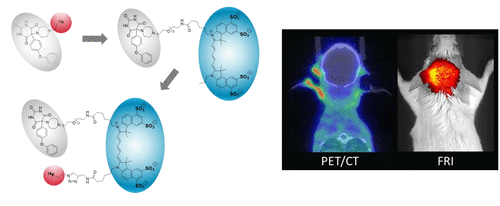当前位置:
X-MOL 学术
›
Bioconjugate Chem.
›
论文详情
Our official English website, www.x-mol.net, welcomes your feedback! (Note: you will need to create a separate account there.)
Optimizing the Biodistribution of Radiofluorinated Barbiturate Tracers for Matrix Metalloproteinase Imaging by Introduction of Fluorescent Dyes as Pharmacokinetic Modulators.
Bioconjugate Chemistry ( IF 4.7 ) Pub Date : 2020-03-17 , DOI: 10.1021/acs.bioconjchem.9b00817 Katrin Schwegmann 1 , Michael Hohn 2, 3 , Sven Hermann 1 , Michael Schäfers 1, 2 , Burkhard Riemann 2 , Günter Haufe 3 , Stefan Wagner 2 , Hans-Jörg Breyholz 2
Bioconjugate Chemistry ( IF 4.7 ) Pub Date : 2020-03-17 , DOI: 10.1021/acs.bioconjchem.9b00817 Katrin Schwegmann 1 , Michael Hohn 2, 3 , Sven Hermann 1 , Michael Schäfers 1, 2 , Burkhard Riemann 2 , Günter Haufe 3 , Stefan Wagner 2 , Hans-Jörg Breyholz 2
Affiliation

|
Dysregulated expression or activation of matrix metalloproteinases (MMPs) is observed in many kinds of life-threatening diseases. Therefore, MMP imaging—for example, with radiolabeled MMP inhibitors (MMPIs)—potentially represents a valuable tool for clinical diagnostics using noninvasive single photon emission computed tomography (SPECT) or positron emission tomography (PET) imaging. Despite numerous preclinical imaging approaches, translation to a clinical setting has not yet been successful. We introduce and oppose three potential radiofluorinated MMP-targeted imaging probes, modified by the introduction of pentamethine cyanine (Cy5) dyes and therefore containing both radio- as well as fluorescent label with respect to their capability to assess MMP activity in vivo by means of scintigraphic (PET) and/or fluorescent (NIRF) imaging. New hybrid MMPI tracer candidates, structurally based on radiofluorinated pyrimidine-2,4,6-triones (barbiturates) from previous approaches, were synthesized by convenient two-step syntheses. In the first step, Cy5 dyes, varying in the number of sulfonate groups (nSO3– = 1, 2, or 4) and bearing an additional “clickable“ alkyne moiety, were coupled to the barbiturate MMPI by amide formation. In the second step, the [18F]fluoride radiolabel was introduced into the resulting Cy5 dye conjugates by “radio-click“ chemistry. Biodistribution studies of these hybrid tracer candidates were assessed and compared in C57BL/6 mice by PET as well as fluorescence imaging. MMP activity was imaged in a MMP-positive mouse model of irritant contact dermatitis (ICD) by PET and sequential fluorescence reflectance imaging (FRI), respectively. In vivo data were validated by scintillation counting, gelatin zymography, and MMP-histology. Three new potential hybrid MMP imaging probes were prepared, differing essentially in the number of sulfonate groups, introduced by Cy5 dye components. Although the hydrophilicity of these compounds was substantially increased, 10a (nSO3– = 1) and 10b (nSO3– = 2) were still rapidly eliminated via unfavorable hepatobiliary pathways, as observed in earlier approaches. Only 11 (nSO3– = 4) showed delayed in vivo clearance and a shift towards higher renal elimination. In the chosen mouse model of ICD, only 11 (nSO3– = 4) significantly accumulated in the inflamed mouse ear, which could be precisely visualized by means of PET and FRI.
中文翻译:

通过引入荧光染料作为药代动力学调节剂,优化用于基质金属蛋白酶成像的放射性氟化巴比妥酸盐示踪剂的生物分布。
在许多威胁生命的疾病中观察到基质金属蛋白酶(MMP)的表达失调或激活。因此,例如使用放射性标记的MMP抑制剂(MMPI)进行MMP成像可能代表使用无创单光子发射计算机断层扫描(SPECT)或正电子发射断层扫描(PET)成像进行临床诊断的有价值的工具。尽管有许多临床前成像方法,但翻译到临床环境尚未成功。我们引入并反对三种潜在的以放射性氟化为靶点的MMP成像探针,这些探针经过引入五甲胺花青(Cy5)染料的修饰,因此就其评估体内MMP活性的能力而言,既包含放射性标记又包含荧光标记通过闪烁显像(PET)和/或荧光(NIRF)成像。通过方便的两步合成方法合成了新的杂化MMPI示踪剂候选物,其结构基于先前方法中的放射性氟化嘧啶-2,4,6-三酮(巴比妥酸酯)。第一步,将具有磺酸根基团数量(n SO 3 – = 1、2或4)且带有一个额外的“可点击”炔烃基团的Cy5染料通过酰胺形成偶联到巴比妥酸酯MMPI上。在第二步中,[ 18通过“ radio-click”化学方法将F]氟化物放射性标记物引入所得的Cy5染料缀合物中。评估了这些杂交示踪剂候选物的生物分布研究,并通过PET和荧光成像在C57BL / 6小鼠中进行了比较。MMP活性分别通过PET和顺序荧光反射成像(FRI)在刺激性接触性皮炎(ICD)的MMP阳性小鼠模型中成像。体内数据通过闪烁计数,明胶酶谱和MMP组织学验证。制备了三种新的潜在杂化MMP成像探针,它们在Cy5染料组分引入的磺酸根基团数量上基本不同。尽管这些化合物的亲水性大大提高,但10a(n SO 3 –如早期方法所观察到的,通过不利的肝胆途径仍迅速消除了= 1)和10b(n SO 3 – = 2)。只有11(n SO 3 – = 4)表现出体内清除延迟,并趋向于更高程度的肾脏消除。在选择的ICD小鼠模型中,发炎的小鼠耳朵中仅11(n SO 3 – = 4)显着积累,这可以通过PET和FRI精确显示。
更新日期:2020-04-23
中文翻译:

通过引入荧光染料作为药代动力学调节剂,优化用于基质金属蛋白酶成像的放射性氟化巴比妥酸盐示踪剂的生物分布。
在许多威胁生命的疾病中观察到基质金属蛋白酶(MMP)的表达失调或激活。因此,例如使用放射性标记的MMP抑制剂(MMPI)进行MMP成像可能代表使用无创单光子发射计算机断层扫描(SPECT)或正电子发射断层扫描(PET)成像进行临床诊断的有价值的工具。尽管有许多临床前成像方法,但翻译到临床环境尚未成功。我们引入并反对三种潜在的以放射性氟化为靶点的MMP成像探针,这些探针经过引入五甲胺花青(Cy5)染料的修饰,因此就其评估体内MMP活性的能力而言,既包含放射性标记又包含荧光标记通过闪烁显像(PET)和/或荧光(NIRF)成像。通过方便的两步合成方法合成了新的杂化MMPI示踪剂候选物,其结构基于先前方法中的放射性氟化嘧啶-2,4,6-三酮(巴比妥酸酯)。第一步,将具有磺酸根基团数量(n SO 3 – = 1、2或4)且带有一个额外的“可点击”炔烃基团的Cy5染料通过酰胺形成偶联到巴比妥酸酯MMPI上。在第二步中,[ 18通过“ radio-click”化学方法将F]氟化物放射性标记物引入所得的Cy5染料缀合物中。评估了这些杂交示踪剂候选物的生物分布研究,并通过PET和荧光成像在C57BL / 6小鼠中进行了比较。MMP活性分别通过PET和顺序荧光反射成像(FRI)在刺激性接触性皮炎(ICD)的MMP阳性小鼠模型中成像。体内数据通过闪烁计数,明胶酶谱和MMP组织学验证。制备了三种新的潜在杂化MMP成像探针,它们在Cy5染料组分引入的磺酸根基团数量上基本不同。尽管这些化合物的亲水性大大提高,但10a(n SO 3 –如早期方法所观察到的,通过不利的肝胆途径仍迅速消除了= 1)和10b(n SO 3 – = 2)。只有11(n SO 3 – = 4)表现出体内清除延迟,并趋向于更高程度的肾脏消除。在选择的ICD小鼠模型中,发炎的小鼠耳朵中仅11(n SO 3 – = 4)显着积累,这可以通过PET和FRI精确显示。


























 京公网安备 11010802027423号
京公网安备 11010802027423号